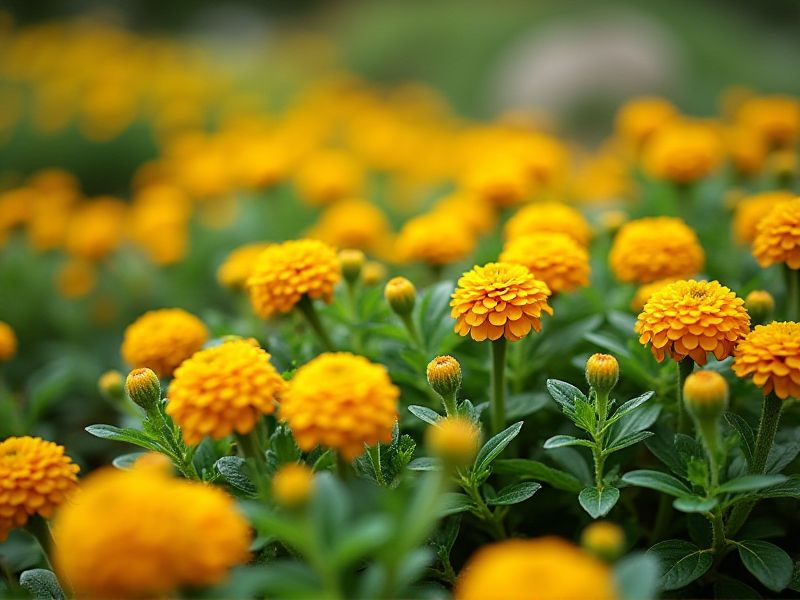
Ground-cover plants that bloom densely, such as Creeping Phlox (Phlox subulata), provide vibrant color and texture to landscapes. These perennials create a lush carpet of flowers in spring, attracting pollinators like bees and butterflies. Sedum species, particularly Sedum spurium, are also popular for their succulent leaves and clusters of star-shaped blooms that thrive in full sun. Furthermore, Ajuga reptans, or Bugleweed, offers an eye-catching display of blue flowers and forms a dense mat, making it ideal for shaded areas. Integrating these plants into your garden not only enhances aesthetic appeal but also supports biodiversity and soil health.
List of some Ground-cover plants that bloom densely
- Creeping Thyme (Thymus serpyllum)
- Blue Star Creeper (Isotoma fluviatilis)
- Irish Moss (Sagina subulata)
- Dead Nettle (Lamium maculatum)
- Creeping Jenny (Lysimachia nummularia)
- Snow-in-Summer (Cerastium tomentosum)
- Lilyturf (Liriope muscari)
- Bugleweed (Ajuga reptans)
- Mazus (Mazus reptans)
- Candytuft (Iberis sempervirens)
Important things about Ground-cover plants that bloom densely
Types Of Ground-Cover Plants
Ground-cover plants that bloom densely are vital for enhancing garden aesthetics while controlling soil erosion. Varieties such as creeping phlox, ajuga, and thyme provide vibrant color and texture, thriving in various climates. These low-maintenance options flourish in sun or shade, attracting pollinators like bees and butterflies to your outdoor space. Choose the right species to create a lush, vibrant carpet of flowers, transforming your landscape into a lively and sustainable haven.
Blooming Seasons
Ground-cover plants that bloom densely create vibrant carpets of color in gardens and landscapes during their blooming seasons. Examples like creeping phlox, with its stunning clusters of pink, purple, and white flowers, provide both aesthetic appeal and erosion control. Another noteworthy option is the trailing lantana, which attracts pollinators with its small, bright blooms that flourish throughout the warmer months. By selecting these hardy plants, you can enhance the beauty of your outdoor spaces while minimizing maintenance efforts.
Growing Conditions
Ground-cover plants that bloom densely thrive in well-drained soil and require adequate sunlight for optimal growth. Species such as creeping thyme and dwarf perennial phlox are excellent choices for vibrant seasonal color, flourishing best in USDA hardiness zones 3 through 9. To promote lush blooming, maintain moist but not soggy conditions and consider mulching to retain soil moisture and suppress weeds. Regular deadheading can extend the flowering period, ensuring your landscape remains attractive throughout the growing season.
Drought Tolerance
Ground-cover plants that bloom densely not only beautify landscapes but also exhibit remarkable drought tolerance, making them ideal for sustainable gardening. Species such as Creeping Thyme (Thymus serpyllum) and Sedum (Sedum spp.) thrive in arid conditions, requiring minimal water while providing vibrant flowers that attract pollinators. These resilient plants effectively reduce soil erosion and improve soil health, contributing to an eco-friendly gardening solution. By incorporating these drought-tolerant ground covers, you can create a visually appealing garden that conserves water and supports local ecosystems.
Maintenance Requirements
Ground-cover plants that bloom densely, such as Creeping Phlox and Ajuga, require minimal maintenance to thrive. Regular watering during dry spells is essential for promoting their vibrant blooms, helping to maintain soil moisture and health. Annual pruning encourages denser growth and prevents overcrowding, ensuring that each plant receives enough sunlight. Applying a layer of mulch can suppress weeds and retain moisture, enhancing the overall appearance and health of your garden.
Pest Resistance
Ground-cover plants that bloom densely offer excellent pest resistance while providing vibrant aesthetics to your landscape. Varieties such as Creeping Thyme and Ajuga are known for their natural ability to deter pests through their strong fragrances and dense foliage. These resilient plants create a protective barrier for your garden, minimizing the chances of pest infestation and reducing the need for chemical treatments. Consider incorporating these ground-cover options into your landscape for a low-maintenance solution that enhances beauty while supporting ecological health.
Soil Preferences
Ground-cover plants that bloom densely thrive in well-drained, loamy soil enriched with organic matter. Depending on the species, many of these plants prefer slightly acidic to neutral pH levels, promoting optimal growth and vibrant flowers. To enhance their blooming potential, regular moisture is essential, yet overwatering should be avoided to prevent root rot. Incorporating mulch can not only help retain soil moisture but also suppress weeds, allowing your ground-cover plants to flourish.
Benefits For Wildlife
Ground-cover plants that bloom densely provide essential habitats and food sources for various wildlife species, including pollinators like bees and butterflies. These thriving plants create a vibrant ecosystem by attracting beneficial insects, which help to maintain ecological balance and promote biodiversity. Their lush foliage offers shelter for small mammals and birds, enabling them to thrive in urban or suburban settings. By incorporating dense-blooming ground-cover plants in your garden, you can support wildlife while enhancing the aesthetic appeal of your outdoor space.
Landscape Applications
Ground-cover plants that bloom densely serve as vibrant additions to any landscape, providing both aesthetic appeal and functional benefits. Varieties such as Creeping Phlox and Ajuga offer rich colors and resilient growth patterns, ideal for preventing soil erosion and suppressing weeds. These hardy perennials thrive in various conditions, making them suitable for sunny or shaded areas, and often require minimal maintenance once established. By incorporating these blooming ground covers, you enhance your outdoor spaces with lively hues and textures while promoting a healthier garden ecosystem.
Invasive Potential
Ground-cover plants that bloom densely can significantly enhance your landscape while also presenting potential invasiveness issues. Species such as Creeping Jenny (Lysimachia nummularia) and Periwinkle (Vinca minor) are known for their lush carpets of color but can easily overtake native flora if not managed properly. When selecting these plants, it's essential to monitor their growth and spreading habits to prevent them from becoming a nuisance in your garden. By keeping invasive tendencies in check, you can enjoy the beauty of dense blooms without compromising local biodiversity.
